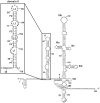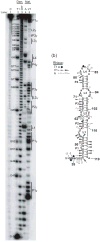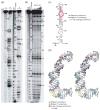Regulation of PKR by HCV IRES RNA: importance of domain II and NS5A
- PMID: 20447405
- PMCID: PMC2902579
- DOI: 10.1016/j.jmb.2010.04.059
Regulation of PKR by HCV IRES RNA: importance of domain II and NS5A
Abstract
Protein kinase R (PKR) is an essential component of the innate immune response. In the presence of double-stranded RNA (dsRNA), PKR is autophosphorylated, which enables it to phosphorylate its substrate, eukaryotic initiation factor 2alpha, leading to translation cessation. Typical activators of PKR are long dsRNAs produced during viral infection, although certain other RNAs can also activate. A recent study indicated that full-length internal ribosome entry site (IRES), present in the 5'-untranslated region of hepatitis C virus (HCV) RNA, inhibits PKR, while another showed that it activates. We show here that both activation and inhibition by full-length IRES are possible. The HCV IRES has a complex secondary structure comprising four domains. While it has been demonstrated that domains III-IV activate PKR, we report here that domain II of the IRES also potently activates. Structure mapping and mutational analysis of domain II indicate that while the double-stranded regions of the RNA are important for activation, loop regions contribute as well. Structural comparison reveals that domain II has multiple, non-Watson-Crick features that mimic A-form dsRNA. The canonical and noncanonical features of domain II cumulate to a total of approximately 33 unbranched base pairs, the minimum length of dsRNA required for PKR activation. These results provide further insight into the structural basis of PKR activation by a diverse array of RNA structural motifs that deviate from the long helical stretches found in traditional PKR activators. Activation of PKR by domain II of the HCV IRES has implications for the innate immune response when the other domains of the IRES may be inaccessible. We also study the ability of the HCV nonstructural protein 5A (NS5A) to bind various domains of the IRES and alter activation. A model is presented for how domain II of the IRES and NS5A operate to control host and viral translation during HCV infection.
2010 Elsevier Ltd. All rights reserved.
Figures










Similar articles
-
Translational insensitivity to potent activation of PKR by HCV IRES RNA.Antiviral Res. 2009 Sep;83(3):228-37. doi: 10.1016/j.antiviral.2009.05.004. Epub 2009 May 23. Antiviral Res. 2009. PMID: 19467267
-
HCV NS5A co-operates with PKR in modulating HCV IRES-dependent translation.Infect Genet Evol. 2014 Aug;26:113-22. doi: 10.1016/j.meegid.2014.04.015. Epub 2014 May 9. Infect Genet Evol. 2014. PMID: 24815730
-
Antiapoptotic and oncogenic potentials of hepatitis C virus are linked to interferon resistance by viral repression of the PKR protein kinase.J Virol. 1999 Aug;73(8):6506-16. doi: 10.1128/JVI.73.8.6506-6516.1999. J Virol. 1999. PMID: 10400746 Free PMC article.
-
Repression of the PKR protein kinase by the hepatitis C virus NS5A protein: a potential mechanism of interferon resistance.Clin Diagn Virol. 1998 Jul 15;10(2-3):157-62. doi: 10.1016/s0928-0197(98)00034-8. Clin Diagn Virol. 1998. PMID: 9741641 Review.
-
Understanding the potential of hepatitis C virus internal ribosome entry site domains to modulate translation initiation via their structure and function.Wiley Interdiscip Rev RNA. 2015 Mar-Apr;6(2):211-24. doi: 10.1002/wrna.1268. Epub 2014 Oct 28. Wiley Interdiscip Rev RNA. 2015. PMID: 25352252 Free PMC article. Review.
Cited by
-
Characteristic chemical probing patterns of loop motifs improve prediction accuracy of RNA secondary structures.Nucleic Acids Res. 2021 May 7;49(8):4294-4307. doi: 10.1093/nar/gkab250. Nucleic Acids Res. 2021. PMID: 33849076 Free PMC article.
-
Ribosomal protein L10(L12)4 autoregulates expression of the Bacillus subtilis rplJL operon by a transcription attenuation mechanism.Nucleic Acids Res. 2015 Aug 18;43(14):7032-43. doi: 10.1093/nar/gkv628. Epub 2015 Jun 22. Nucleic Acids Res. 2015. PMID: 26101249 Free PMC article.
-
Native tertiary structure and nucleoside modifications suppress tRNA's intrinsic ability to activate the innate immune sensor PKR.PLoS One. 2013;8(3):e57905. doi: 10.1371/journal.pone.0057905. Epub 2013 Mar 4. PLoS One. 2013. PMID: 23483938 Free PMC article.
-
Stress granules: potential therapeutic targets for infectious and inflammatory diseases.Front Immunol. 2023 May 2;14:1145346. doi: 10.3389/fimmu.2023.1145346. eCollection 2023. Front Immunol. 2023. PMID: 37205103 Free PMC article. Review.
-
Immune system control of hepatitis C virus infection.Curr Opin Virol. 2021 Feb;46:36-44. doi: 10.1016/j.coviro.2020.10.002. Epub 2020 Nov 1. Curr Opin Virol. 2021. PMID: 33137689 Free PMC article. Review.
References
-
- Balachandran S, Roberts PC, Brown LE, Truong H, Pattnaik AK, Archer DR, Barber GN. Essential role for the dsRNA-dependent protein kinase PKR in innate immunity to viral infection. Immunity. 2000;13:129–141. - PubMed
-
- Williams BR. PKR; a sentinel kinase for cellular stress. Oncogene. 1999;18:6112–6120. - PubMed
Publication types
MeSH terms
Substances
Grants and funding
LinkOut - more resources
Full Text Sources

